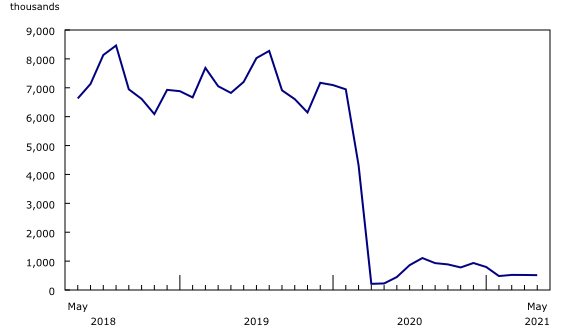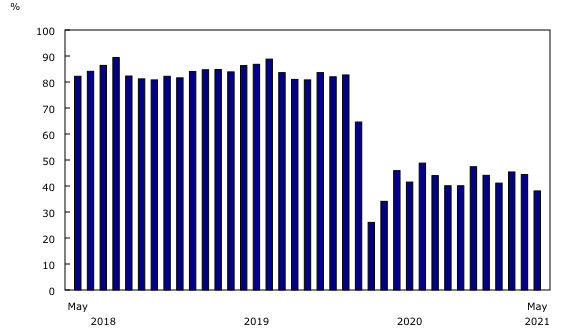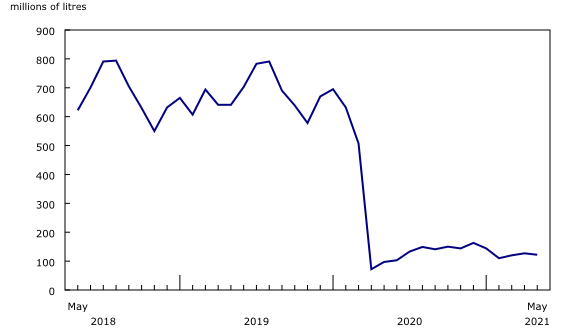Monthly civil aviation statistics, May 2021
Archived Content
Information identified as archived is provided for reference, research or recordkeeping purposes. It is not subject to the Government of Canada Web Standards and has not been altered or updated since it was archived. Please "contact us" to request a format other than those available.
Released: 2021-07-29
Highlights
As travel restrictions continued throughout May, major Canadian airlines carried 514,000 passengers on scheduled and charter services during the month. While more than double the passengers from May 2020, it was down 92.5% from the pre-pandemic level in May 2019.
Traffic and capacity were 94.8% and 88.7% below their pre-pandemic levels, respectively, in May. At 38.1%, the passenger load factor fell below 40% for the first time in a year—since May 2020.
Compared with May 2019, operating revenues were down 85.2% to $296.0 million in May 2021.
Third wave of COVID-19 impedes recovery
With COVID-19 cases expanding into May, so did the measures to contain further spread, including lockdowns, stay-at-home orders and travel restrictions. Several Canadian air carriers' operations remained suspended amid these restrictions and the resulting lack of travel demand. The ban on passenger flights from India and Pakistan was extended for another month due to a more contagious variant of COVID-19 continuing to spread in the region.
On March 11, 2020, COVID-19 was declared a pandemic by the World Health Organization. In the months that followed, Canadian air travel remained well below historical norms. For this reason, unless otherwise specified, comparisons in this release will be made with the same month of 2019 (also referred to as "pre-pandemic"), when airline activity levels were in line with historical trends.
Air travel remains stagnant
Canadian Level I air carriers flew 514,000 passengers on scheduled and charter services in May, down 92.5% from the pre-pandemic level in May 2019.
On a monthly basis, the number of passengers flown in May declined 1.2% from April, attributable to fewer passengers on domestic flights. While the number of passengers on international routes increased for a second month, the two consecutive increases were not sufficient to offset the decline recorded in March.
At 922.0 million passenger-kilometres, traffic in May was 94.8% below the pre-pandemic levels posted in May 2019, while capacity was 2.4 billion available seat-kilometres, down 88.7% from two years earlier.
From April, traffic declined while capacity increased in May. As a result, the passenger load factor (the ratio of passenger-kilometres to available seat-kilometres) dropped to 38.1% in May from 44.4% in April. This was the lowest load factor since May 2020 and represents a sharp drop from the pre-pandemic load factor of 83.9% registered in the same month of 2019.
Other measures remain low
As international traffic remained low, each passenger travelled an average of 1,794 kilometres in May, down 31.6% from May 2019 and the lowest distance recorded in the Monthly civil aviation statistics since November 1984.
At 22,000, the number of flying hours in May was 87.6% below the pre-pandemic level posted in May 2019.
Operating revenue earned by Level I carriers totalled $296.0 million in May, down 85.2% from $2.0 billion reported for May 2019.
Note to readers
The Monthly Civil Aviation Survey covers all Canadian Level I air carriers: Air Canada (including Air Canada Rouge), Air Transat, Jazz, Porter, Sunwing, and WestJet (including Swoop, WestJet Encore and WestJet Link).
The average passenger trip length is calculated by dividing the number of passenger-kilometres by the number of passengers. Trips across Canada and the world are included in this calculation.
The data in this monthly release are not seasonally adjusted.
Contact information
For more information, or to enquire about the concepts, methods or data quality of this release, contact us (toll-free 1-800-263-1136; 514-283-8300; STATCAN.infostats-infostats.STATCAN@canada.ca) or Media Relations (613-951-4636; STATCAN.mediahotline-ligneinfomedias.STATCAN@canada.ca).
- Date modified:







